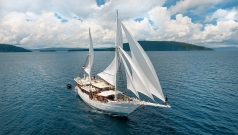Adonara Island
Eastern Flores has some well known dive sites such as Magic Log where ribbon eels and frogfish are common. The very rare weedy scorpionfish (Rhinopias) has been found here, as has the wonderpus octopus. Headlands and channels dot the coastline of the island and these are gradually being explored by divers on visiting liveaboards but there is still a lot of unchartered territory to discover in this region.
Babi Island
This is a surprisingly good dive considering that this Flores island bore the brunt of the 1992 tsunami . 1,000 inhabitants were killed when the wave swept over the island but, over a decade later, the reef wall is in very healthy condition. Dropping down to a depth of about 50 metres, it is sometimes possible to see the sea floor from the surface however a more usual visibility is about 15 metres. Snappers, parrotfish, angelfish and damselfish all occupy the wall. Several species of moray eel can be found as well as ribbon eels.
There is a good covering of soft corals and sponges all along the wall and the brightly coloured crinoids like to jump off the wall to attach themselves to wetsuits of the unsuspecting scuba diver who gets too close. Numerous sea apples add splashes of blue and red colour. Testament to the reef regeneration is the high number of gorgonians along the wall, the biggest ones being found at depths of 35 metres and below. Currents can sometimes be strong here making the right conditions for an excellent drift dive.
Lambata Island
This island is also well worth diving exploration. The headland next to Lamalera Village is worth several days of your time alone. The distant shadows of reef sharks tempt you into the depths from where you can make your way back up through the boulders and coral reef slopes. Schools of fusiliers, angelfish and many different parrotish species are common. Gorgonian seafans host pygmy seahorses. Also, as Lamalera is one of the only 2 traditional whaling villages left in Flores (whatever happened to IWC protection?), the surrounding seas could also hold larger cetacean surprises.
South Pangah Balang
You may have some current to deal with as you descend over the mass of large leather corals which are present in numbers along the sloping wall that plateaus at around 28 metres. Soft corals abound here too, in impressive sizes and spectacular colours. The sight is enough to take your breath away but faces competition in this regard from the finning you may be doing to combat the current.
Just above the sandy floor, divers may catch sight of any number of sharks and eagle rays lazily hanging in the current, and garden eels easing themselves into their bottom holes as you pass above. All the while colour will surround you in the shallows where you may find mantis shrimps, several leaffish and other small interesting animals. Bumphead parrotfish a metre in length are also often seen as they storm over the reef. When air dictates you will emerge, perhaps a little drained, but certainly energised by this excellent dive site.
Wai Terang
Just off the coast of mainland Flores, divers will find this Japanese World War II freighter lying on its side from a depth of 25 metres up to about 12 metres. The coral growth on this wreck has improved considerably over the years and now the old ship plays host to a fair number of hard and soft corals harbouring small fish life.
One thing you should try to avoid is kicking up the silt here since a careless hand or leg in poor visibility could bring your skin into contact with one of the many resident lionfish, a sensation worse than a nip. Eels, cuttlefish and anthias are among the other pleasures to be had on what is a very rewarding wreck dive, if not one that allows too much penetration.
























